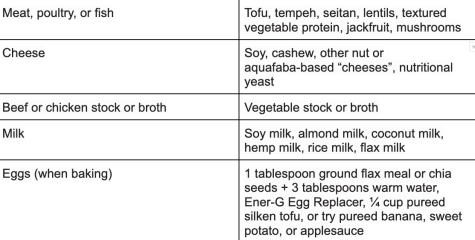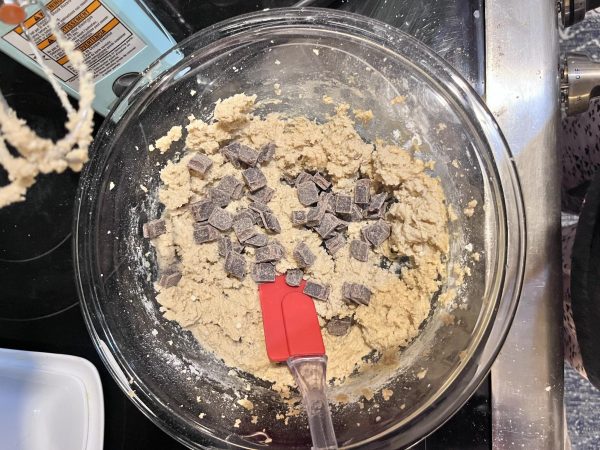How To Easily Become a Vegetarian

Photo courtesy of Elise Douglas
Young staff writer Luiza Douglas chows down on a salad outside the restaurant, Johnny’s New York Style Pizza
With the vegetarian phenomenon sweeping the nation, many people wish to hop on the healthy and sustainable trend. But how does one just become a vegetarian? As a new vegetarian in a Latina household, I’ve had to adapt new ways to transition into being a full-fledged vegetarian.
What is a plant-based diet?
Before we get into how to become a vegetarian, let’s discuss what being a vegetarian truly is. A vegetarian is someone with a diet primarily made up of greens, fruits, nuts, whole grains, mushrooms, seeds, herbs, and spices according to Julieanna Hever, California-based nutritionist and founder of Plant-Based Dietician. Though being vegetarian does not have to be as boring as that sounded. To go into specifics, some plant-based diets are more complex than the average, “will not eat meat” vegetarian.
The 3 types of vegetarians are as follows, lacto-ovo vegetarians (who eat both eggs and dairy products), lacto vegetarians (who eat dairy products but not eggs), and ovo vegetarians (who eat eggs but not dairy products).
Some vegetarians aren’t limited by meat though, such as vegetarians that don’t eat meat but still eat other animal foods. Such as pescatarians (eat fish but avoid all other meat) and pollo vegetarians (eat poultry but avoid other meat and fish).
For a while, I was what I called a ‘chicketarian’ where I didn’t eat any meat except chicken. I couldn’t bring myself to part from the #1 chicken sandwich from Chick-fil-A.
What are the positive benefits of changing your diet?
Compared to regular meat, Beyond Meat produces 90% less carbon emissions during production. By reducing red meat, your body can benefit as well. Cutting back on burgers and steak can help reduce inflammation, cholesterol, and more. I’ve known people who have transitioned into a vegetarian diet for their hearts. Vegetarians may be up to 1/3 less likely to die or be hospitalized for heart disease. The increased amount of nutrients in a plant-based diet also reduces the risk of cancer, lowers blood pressure, decreases asthma symptoms, and promotes bone health.
Easy strategies to get started
First, You’re gonna want to start slow. By taking one meat out for one month, you can allow your body, mind, and family to adjust to the new diet. For me, I took out beef first.
By only getting rid of one meat, I could allow myself to transition easier into a vegetarian diet. I admire those who could just give up meat cold turkey and never look back. By ensuring that I couldn’t eat beef but I could still eat fish and chicken, my mind started to just not crave beef after the first month of no beef. As I continued to give up meat, I stopped craving it. I’m sure a couple of years ago I would have been drooling at the thought of a cheeseburger, but now that I see what life can be like without it, it’s not something I would look forward to.
Now, as I started to substitute regular meat with Beyond Meat, the process became even easier because I didn’t have to sacrifice the meat I loved forever. (This article is not sponsored.) Beyond Meat is a great alternative to meat cravings. I’ve tried some beyond meats that taste almost exactly like real meat, with extra nutrients.
Second, an easy way to make becoming a vegetarian less burdensome is to plan meals ahead of time. It could be as easy as planning each cheese quesadilla or a more complex vegetarian meal of a salad with lettuce and protein alternatives like beans, quinoa, or nuts.
Start with meals you have always enjoyed that just happen to be plant-based or are easily made meatless, such as oatmeal, pasta primavera, jacket potatoes, veggie stir-fry, burritos, lentil stew, or three-bean chili. Then, build on those meals. Since we’re creatures of habit, we tend to stick to fewer different dishes, so start slowly and learn this new language of food without any pressure to be perfect.
By resisting temptations, you are less likely to eat the meat that you are trying to give up. I often avoid meat-based restaurants such as Lucky Burgers, Chick-fil-A, and Taco Bell. Though these restaurants have some meat alternatives, the meaty options always look better to me in the moment.
Also, make sure to have some healthy swaps. Personally, I didn’t know what a healthy vegetarian diet consisted of when I first started so I made a quick chart of what you can replace meat within your diet to maintain protein and nutrients in your meals.

While you should keep in mind that it’s good to be consistent with your new vegetarian diet, give yourself some wiggle room. Much of this is about trial and error, finding out what works for you and what doesn’t. Be gentle with yourself as you find your rhythm to remove meats and incorporate plant-based foods into your diet.
Your donation will support the student journalists of Chamblee High School Blue & Gold. Your contribution will allow us to print editions of our work and cover our annual website hosting costs. Currently, we are working to fund a Halloween satire edition.

Luiza Douglas ('24) is a senior and the Senior Editor for the Blue & Gold. In five years, she hopes to be living in the big city (wherever it may be), or still in Mr. Avett's class. Her three favorite things are Lana Del Rey, Boston Clogs, and being vegetarian.











Elizabeth Avett • Mar 7, 2022 at 10:57 am
Good guide!!